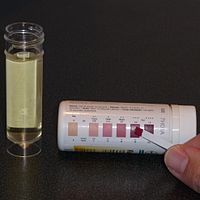
Photo from wikipedia
Background: A range of computational methods that rely on the analysis of genome-wide expression datasets have been developed and successfully used for drug repositioning. The success of these methods is… Click to show full abstract
Background: A range of computational methods that rely on the analysis of genome-wide expression datasets have been developed and successfully used for drug repositioning. The success of these methods is based on the hypothesis that introducing a factor (in this case, a drug molecule) that could reverse the disease gene expression signature will lead to a therapeutic effect. However, it has also been shown that globally reversing the disease expression signature is not a prerequisite for drug activity. On the other hand, the basic idea of significant anti-correlation in expression profiles could have great value for establishing diet-disease associations and could provide new insights into the role of dietary interventions in disease. Methods: We performed an integrated analysis of publicly available gene expression profiles for foods, diseases and drugs, by calculating pairwise similarity scores for diet and disease gene expression signatures and characterizing their topological features in protein-protein interaction networks. Results: We identified 485 diet-disease pairs where diet could positively influence disease development and 472 pairs where specific diets should be avoided in a disease state. Multiple evidence suggests that orange, whey and coconut fat could be beneficial for psoriasis, lung adenocarcinoma and macular degeneration, respectively. On the other hand, fructose-rich diet should be restricted in patients with chronic intermittent hypoxia and ovarian cancer. Since humans normally do not consume foods in isolation, we also applied different algorithms to predict synergism; as a result, 58 food pairs were predicted. Interestingly, the diets identified as anti-correlated with diseases showed a topological proximity to the disease proteins similar to that of the corresponding drugs. Conclusions: In conclusion, we provide a computational framework for establishing diet-disease associations and additional information on the role of diet in disease development. Due to the complexity of analyzing the food composition and eating patterns of individuals our in silico analysis, using large-scale gene expression datasets and network-based topological features, may serve as a proof-of-concept in nutritional systems biology for identifying diet-disease relationships and subsequently designing dietary recommendations.
Journal Title: Frontiers in Physiology
Year Published: 2017
Link to full text (if available)
Share on Social Media: Sign Up to like & get
recommendations!